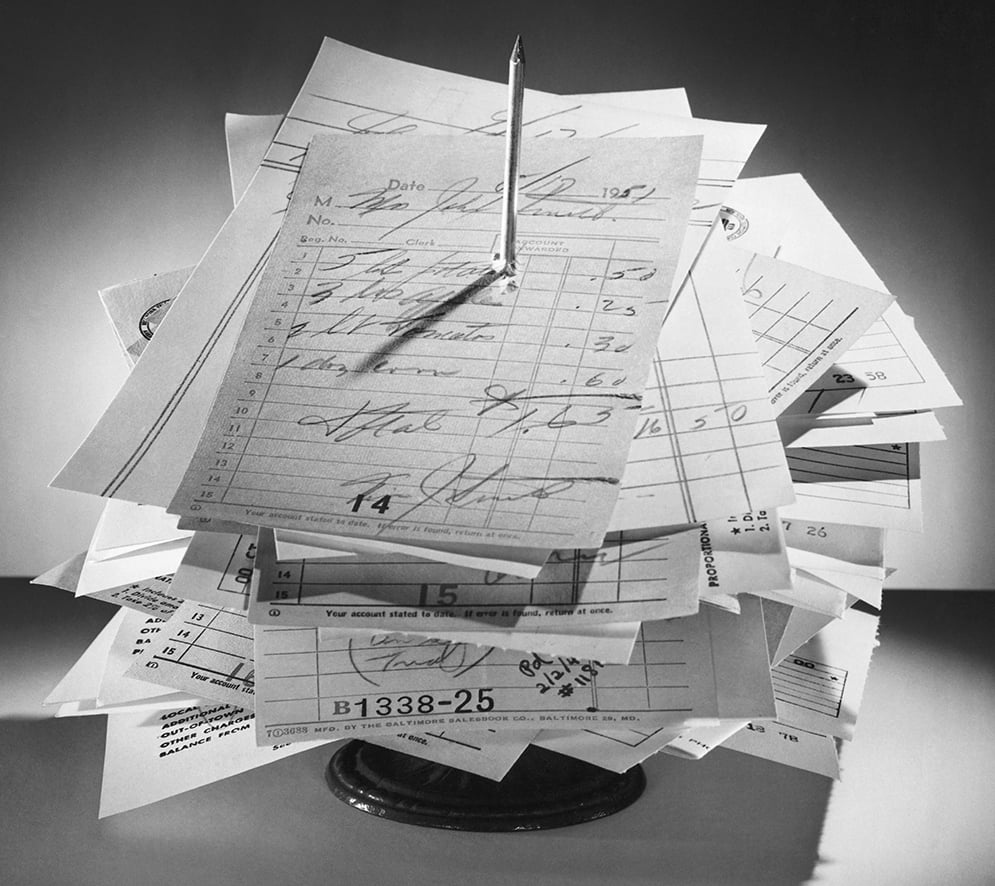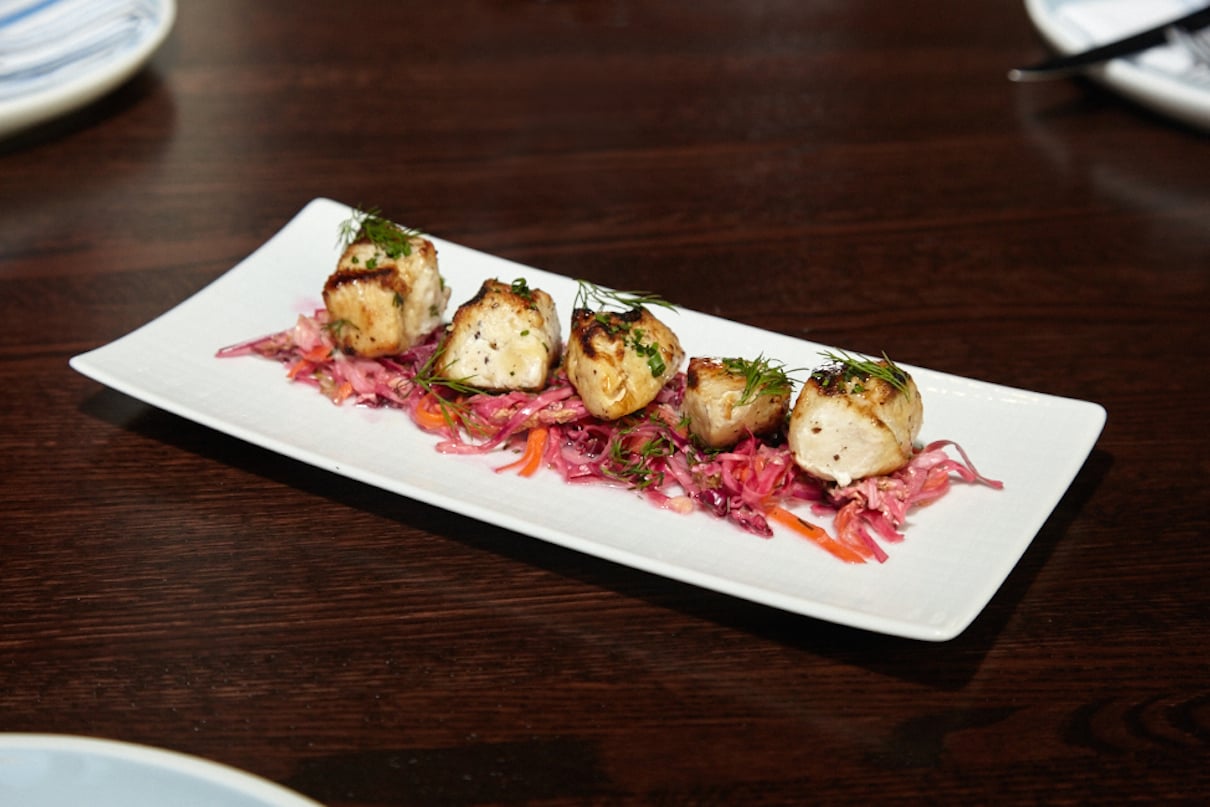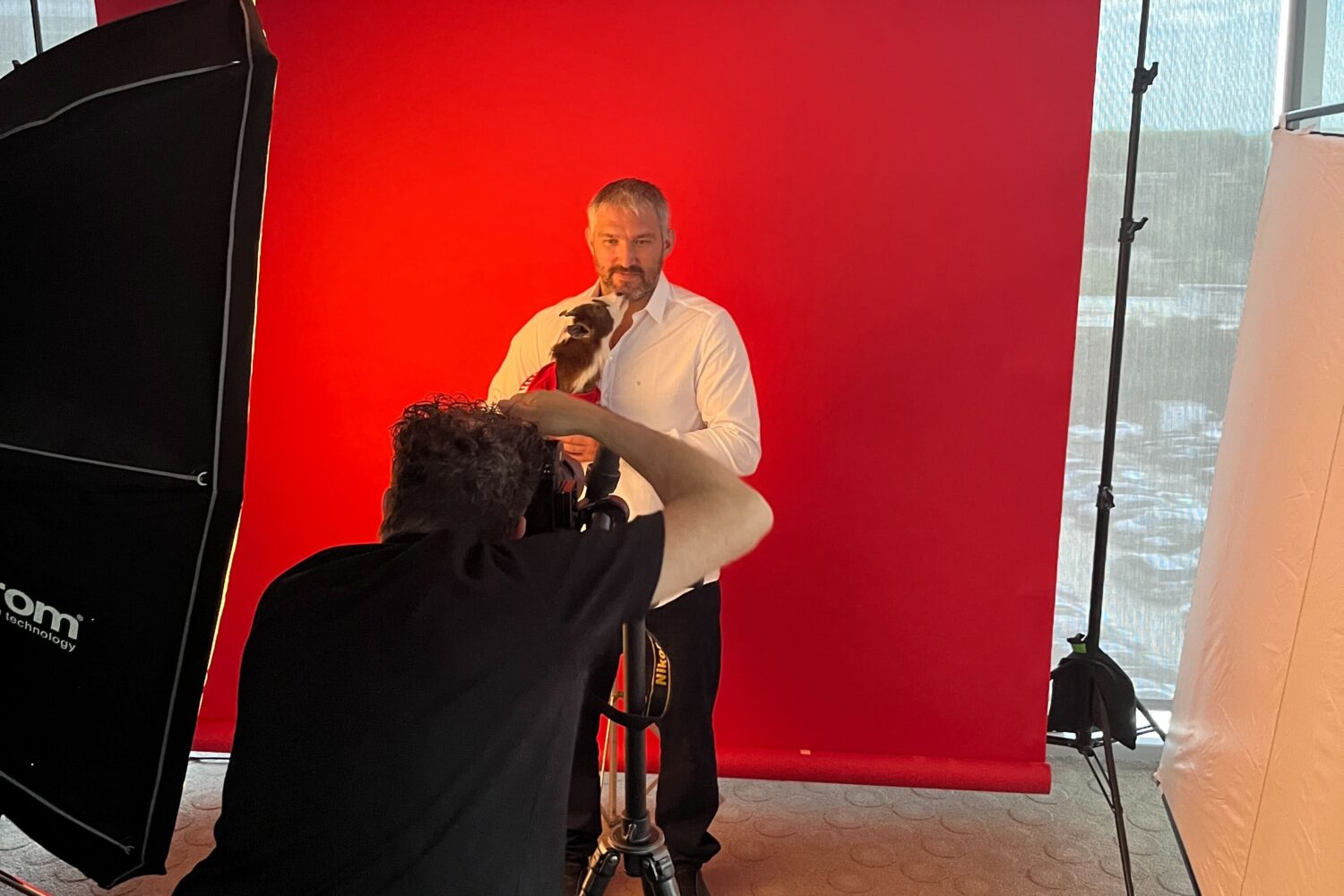Neal Wavra, sommelier at the Ashby Inn in Paris, Virginia, accepted the challenge of choosing Virginia wines for a blind tasting against some of France’s famous Sauternes. Photograph by Scott Suchman
In what was a different world—one in which financial companies rewarded valued employees with lavish vacations—my wife, Marti, and I were given a trip to the renowned Château d’Yquem vineyard in Bordeaux, France, several years ago. The chateau served a five-course dinner in which every course was matched with a d’Yquem wine from the vineyard’s most highly rated vintages.
Michelin three-star chef Michel Trama of L’Aubergade restaurant in Puymirol, near Bordeaux, paired course after course with one of the famously sweet Sauternes. A crunchy cone filled with sea scallops and osetra caviar was accompanied by the 2000 vintage. A fresh Brittany lobster poached in coconut sauce was paired with the 1998 vintage, pan-seared Gascony duck liver with the 1986, and potato en papillote stuffed with black truffles with the 1976. Dessert—raspberries topped with vanilla-scented, honey-based jelly—was served with the 1937 vintage, which wine writer Robert Parker once declared was matched only by the 1921 vintage.
On its face, the idea of pairing sweet wines with every course in a meal had seemed all but impossible. But thanks to our once-in-a-lifetime experience, we knew it could be done—and brilliantly.
***
A year ago, we enjoyed with friends a local twist on the famed 1976 winetasting now known as the “Judgment of Paris.” Ours was held in Paris, Virginia, at the historic Ashby Inn. The inn, built around 1829, is near the Ashby Gap in the Blue Ridge Mountains, through which Route 50 now passes. Confederate generals Joseph Johnston and Stonewall Jackson rested at the Ashby Inn on their way to the First Battle of Manassas the night of June 17, 1861.
Much like the 1976 Judgment of Paris, in which California wines fared favorably against French wines in a blind tasting, our blind tasting pitted Virginia wines against comparably priced wines from around the world. To the surprise of many, the Virginia wines fared well against the competition. Most tasters, who included wine professionals, serious amateurs, and recreational tasters, couldn’t tell the Virginia wines from the imports—and tended overall to prefer the Virginia ones. An article about the event, titled “Judgment of Paris,” appeared in the September 2009 Washingtonian.
How They Ranked
1. 2001 Rieussec, France (375 ml, $99)
2. 2008 Rockbridge V d’Or, Virginia (375 ml, $24)
3. 2005 Château d’Yquem, France (375 ml, $325)
4. 2006 Linden Late Harvest Petit Manseng, Virginia (375 ml, $28)
5. 2000 Linden Late Harvest Vidal, Virginia (375 ml, $23)
6. 1971 Rieussec, France (750 ml, $125)
7. 2007 Veritas Kenmar, Virginia (375 ml, $35)
8. 1975 Château Suduiraut, France (750 ml, $65)
Everyone who attended the Virginia tasting seemed to have a good time. I thought of it as a one-time event until Marti raised the possibility of doing it again—this time making it a version of our Château d’Yquem experience. We would taste some of the world’s great Sauternes—including the 2005 Château d’Yquem and the 2001 Rieussec (awarded 100 points by Wine Spectator magazine)—against sweet wines from Virginia, of which there are at least as many as there are Virginia vineyards.
At first, the idea of tasting legendary Sauternes against Virginia dessert wines seemed unfair. We imagined that the contest would more resemble the movie Rocky than Bottle Shock—the film about the real Judgment of Paris—but given the results of the previous tasting, who knew?
***
We returned to the Ashby Inn not only because it had been the venue of our original contest but also because chef Tarver King had taken over the kitchen and sommelier Neal Wavra the wine service. Together they’re turning the inn into one of the area’s destination restaurants.
Chef King comes from a food-family background. His grandmother was food editor of Vogue in the 1960s and ’70s and published several cookbooks in addition to contributing to Gourmet cookbooks. King began his culinary career in his hometown of Virginia Beach apprenticing for three-star chef Alain Jackmin at Le Chambord. He has worked in the kitchens of such restaurants as Le Bec Fin, the Inn at Little Washington, the French Laundry, the Fat Duck, and the Waterside Inn. In his first head-chef job—at the Dining Room at the Woodlands Inn in Summerville, South Carolina—he received Mobil five-star and AAA five-diamond ratings; both Esquire and Wine Spectator deemed him one of the top chefs to watch. Who better to take a chance on to match dishes with sweet wines?
Neal Wavra, a member of the Court of Master Sommeliers, graduated from the Culinary Institute of America before touring the great wine regions of the world on scholarship and beginning his restaurant career in Chicago at Charlie Trotter’s, where he became dining-room manager within seven months. Next he was farmstead and dining-room manager at Blackberry Farm in Tennessee. Now it was Wavra’s job to choose the Virginia wines to taste alongside the Sauternes we had bought for the event.
***
The Ashby Inn’s veranda was the perfect setting on a beautiful summer afternoon. Four food-and-wine stations, where tasters would sip and ponder, were placed among the dining tables. Wavra handed each person a score sheet. On it were listed the bite of food served at each station and an alphabetical letter assigned to each wine. At each station were two wines, one from Virginia, the other from France. Tasters, including my wife and me, were asked to note which of the two wines they liked better and to assign each a score from one to five, with five the highest. They also were asked which wine they thought was from Virginia and which from France. Finally, they were to note which wine they liked best overall and which food-and-wine pairing was their favorite.
Wavra began the tasting with a talk about sweet wines—the ways they’re made, the types of grapes used, and the standards for pairing sweet wines and food. He said wines and foods should both complement and contrast with each other—spiciness with sweetness, sweetness with sweetness, fruitiness with more fruitiness. There are no hard-and-fast rules. When a pairing works well, the wine enhances the food and vice versa.
Wavra noted that many people’s introduction to wine is via the sweet variety—and usually not a very sophisticated version. He pointed out how hard it is to produce a good sweet wine—and how elegant and lyrical such wines can be. He didn’t mention that in two pairings, tasters would be comparing Sauternes that cost $325 and $99 for a half bottle with Virginia wines costing less than $30. (Except where noted, prices listed are for half bottles, or 375 milliliters.)
***
The bottles were wrapped in foil to hide their identities. Tasters could sample the pairings in whatever order and as many times as they liked. Most tasters took the food-and-wine pairings to the dining tables so they could taste, compare, and make judgments in a leisurely fashion. By the third pairing, most of us were surrounded by partially filled glasses, allowing us to compare not only the matched wines but also those previously tasted to better award points and select an overall winner.
Linden Vineyards winemaker Jim Law, two of whose wines were in the contest, sat at a table in the corner seriously sipping and dutifully scribbling his impressions. He was joined by sommelier Richard Dunham of L’Auberge Chez François and his wife, Darden Paule, as well as Kathleen Burke, who had distinguished herself at the 2009 tasting by correctly identifying every Virginia wine. This quickly became the experts’ table.
The premier food-and-wine match of the event was a seemingly simple blackberry beignet served with one of the world’s greatest wines, the 2005 d’Yquem, and a 2008 Rockbridge V d’Or, the signature ice wine of Virginia’s Rockbridge Vineyard.
Rockbridge, in the Shenandoah Valley near Lexington and Staunton, is owned by Shepherd and Jane Millott-Rouse. Shepherd has a master’s degree in enology from the University of California at Davis and has worked in such California wineries as Schramsberg, Chateau St. Jean, and Carneros Creek. The $24 V d’Or is a blend of Vidal Blanc, Riesling, Vignoles, and Traminette. The grapes are pressed while frozen. When the grapes start defrosting, the rich juice drips into a pan underneath the grape press. After 12 months of fermentation, the golden Virginia wine is bottled. To most everyone’s astonishment, the tasters favored it over the d’Yquem, rating it the second-best wine of all those tasted. The Château d’Yquem ranked third-best overall.
***
Chef King prepared a creamy rabbit-liver parfait with brown butter and truffle to accompany a 1971 Rieussec ($125 a full bottle, or 750 milliliters) and a 2007 Veritas Kenmar ($35). Rieussec, arguably the second-most famous Sauternes, is made on property overlooking the Garonne River that has been producing wines since the 1700s. The 1971 vintage is considered one of the best in decades. The Veritas Kenmar is made by Emily Hodson Pelton, who has a master’s in enology from Virginia Tech. Her parents, Andrew and Patricia Hodson, own the Afton, Virginia, vineyard. The Rieussec won this paring and ranked sixth overall. The Veritas Kenmar ranked seventh.
The most daring pairing involved bouchot mussels stewed in wine with curry and lime—the taste was tart and the texture chewy. It was matched with a 1975 Château Suduiraut ($65 for a full bottle) and a 2000 Linden Late Harvest Vidal ($23). The Suduiraut is made of 90 percent Semillon grape, which is particularly suited to “noble rot,” the process whereby the Botrytis cinerea fungus attacks ripened grapes, absorbing moisture and concentrating the sugar. The Linden late-harvest grapes come from 21-year-old vines, some of the vineyard’s oldest. The grapes are frozen, then pressed, a process known as cryoextraction, and only the first thawed juice is used. In another surprise, the Linden wine was the favorite in this pairing and was ranked fifth overall. The Suduiraut ranked last overall.
Perhaps the most traditional course was Colston Bassett Stilton with pear jelly, but Chef King admitted that his most difficult choices, involving numerous tastings by his staff, were what type of Stilton to choose and in what form to serve the pear. The wines selected were the 100-point 2001 Rieussec ($99) and a 2006 Linden Late Harvest Petit Manseng ($28). The Petit Manseng grape originally comes from the Jurançon region of southwestern France and is high in acidity, making it ideal for a dessert wine. The Virginia wine was rated second to the French and fourth overall. The glamorous 2001 Rieussec was ranked best overall.
***
At the end of the afternoon, Neal Wavra announced the results. “Biases were dashed, and a 100-point score was upheld,” he said. “It was a successful tasting.”
There was general surprise at the Château d’Yquem showing—most of us supposed that for all its vaunted reputation, it should have shouted its superiority. That it did not underscores the fact that the wines ranged from very good to extraordinary—the differences among them were subtle. And this time we weren’t shocked by how well the Virginia wines did. Interestingly, exactly half of the wines identified as the better of the two in each pairing came from Virginia and half from France.
The lesson of this tasting is that very good wines of all kinds are being produced around the world—including in Virginia—and not all of them have three-figure price tags.
This article appears in the September 2010 issue.















